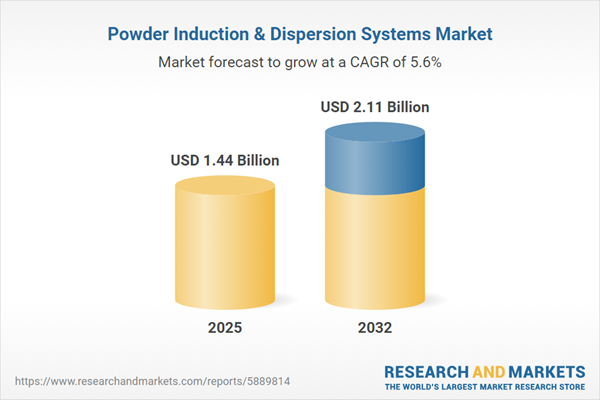Speak directly to the analyst to clarify any post sales queries you may have.
The powder induction and dispersion systems market is advancing rapidly, as manufacturers across multiple sectors seek innovative equipment that optimizes process safety, efficiency, and integration. Senior decision-makers benefit from a clear understanding of how technology shifts, regulatory triggers, and procurement criteria are shaping industry standards and implementation strategies.
Market Snapshot: Powder Induction & Dispersion Systems Industry Overview
The Powder Induction & Dispersion Systems Market grew from USD 1.37 billion in 2024 to USD 1.44 billion in 2025. It is expected to continue growing at a CAGR of 5.58%, reaching USD 2.11 billion by 2032. The market's momentum reflects heightened demand for enhanced mixing consistency, safety optimization, and digitized process control in continuous and batch production operations. Persistent investment in advanced dispersion methods, robust automation, and compliance-driven features drives widespread adoption in both mature and emerging regions.Scope & Segmentation
- Product Types: Fully Automatic Powder Induction Systems (including High Throughput and Standard Throughput), High Shear Powder Dispersion Systems, Low Shear Powder Dispersion Systems, Manual Powder Induction Systems, Semi-Automatic Powder Induction Systems
- End-Use Industries: Adhesives and Sealants, Chemical Processing (Petrochemicals, Specialty Chemicals), Food Production, Paints and Coatings, Personal Care, Pharmaceuticals
- Applications: Blending Solids, Coating, Dispersing Powders Into Liquids, Emulsification, Granulation
- Operation Modes: Fully Automatic (PLC Controlled, Robot Integrated), Manual, Semi-Automatic
- Material Viscosity Ranges: High Viscosity (greater than 10000 Cp), Medium Viscosity (1000 to 10000 Cp), Low Viscosity (less than 1000 Cp)
- Distribution Channels: Direct Sales (Field Sales, Inside Sales), Distributors (Online Distributors, Regional Distributors), Original Equipment Manufacturer (OEM Partnerships, Private Label)
- Regional Coverage: Americas (United States, Canada, Mexico, Brazil, Argentina, Chile, Colombia, Peru), Europe (United Kingdom, Germany, France, Russia, Italy, Spain, Netherlands, Sweden, Poland, Switzerland), Middle East (United Arab Emirates, Saudi Arabia, Qatar, Turkey, Israel), Africa (South Africa, Nigeria, Egypt, Kenya), Asia-Pacific (China, India, Japan, Australia, South Korea, Indonesia, Thailand, Malaysia, Singapore, Taiwan)
- Major Companies: SPX FLOW, Inc., GEA Group Aktiengesellschaft, Sulzer Ltd, NETZSCH Holding Inc., IKA-Werke GmbH & Co. KG, Charles Ross & Son Company, Ystral GmbH, Silverson Machines Ltd, EKATO Systems GmbH, Hockmeyer Equipment Corporation
Key Takeaways: Strategic Insights for Powder Induction and Dispersion Systems
- Automation is increasingly prioritized, with investments in PLC and robotic integration to improve consistency, reduce operator intervention, and support traceability across industries.
- Hygienic design and safety features have become non-negotiable, especially for food, personal care, and pharmaceutical sectors, to meet stringent compliance and cleanability requirements.
- Procurement criteria extend beyond upfront costs to include lifecycle serviceability, validation support, and aftersales offerings, with vendors formalizing long-term service agreements and validation protocols.
- Product development is strongly influenced by application-specific requirements, driving demand for modular solutions capable of handling diverse shear profiles, viscosities, and throughput classes.
- Regional variations in regulatory rigor, manufacturing maturity, and distribution infrastructure dictate adoption patterns and supplier strategies, particularly across EMEA and Asia-Pacific markets.
Tariff Impact and Supply Chain Resilience
The introduction of increased tariffs in 2025 has directly influenced sourcing and design strategies for powder induction and dispersion system suppliers. Companies have shifted toward supplier diversification, nearshoring of critical subassemblies, and local component sourcing, ensuring continued product performance and availability of key spare parts. These efforts also prompt greater emphasis on landed cost evaluation and more holistic design-for-procurement collaboration between buyers and manufacturers to offset tariff exposure and minimize operational disruptions.
Methodology & Data Sources
This analysis employs a robust mixed-methods approach combining primary interviews with process engineers and procurement leaders, comprehensive technical literature reviews, product specification analysis, and end-to-end supply chain mapping. Triangulated insights ensure findings are relevant to on-the-ground operational realities.
Why This Report Matters for Senior Decision-Makers
- Gain actionable guidance on selecting, specifying, and validating equipment that meets rigorous operational, compliance, and safety demands.
- Benchmark supplier strategies, aftermarket service models, and resilience initiatives for informed, risk-mitigated procurement decisions.
Conclusion
For executive teams shaping procurement and process reliability, this report reveals how lifecycle thinking, modular systems, and collaborative supplier relationships underpin operational consistency and value across industries navigating market and regulatory change.
Additional Product Information:
- Purchase of this report includes 1 year online access with quarterly updates.
- This report can be updated on request. Please contact our Customer Experience team using the Ask a Question widget on our website.
Table of Contents
3. Executive Summary
4. Market Overview
7. Cumulative Impact of Artificial Intelligence 2025
Companies Mentioned
The companies profiled in this Powder Induction & Dispersion Systems market report include:- SPX FLOW, Inc.
- GEA Group Aktiengesellschaft
- Sulzer Ltd
- NETZSCH Holding Inc.
- IKA-Werke GmbH & Co. KG
- Charles Ross & Son Company
- Ystral GmbH
- Silverson Machines Ltd
- EKATO Systems GmbH
- Hockmeyer Equipment Corporation
Table Information
| Report Attribute | Details |
|---|---|
| No. of Pages | 195 |
| Published | October 2025 |
| Forecast Period | 2025 - 2032 |
| Estimated Market Value ( USD | $ 1.44 Billion |
| Forecasted Market Value ( USD | $ 2.11 Billion |
| Compound Annual Growth Rate | 5.5% |
| Regions Covered | Global |
| No. of Companies Mentioned | 11 |









